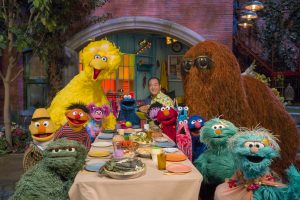I remember so well the days when my now-grown daughter was a little girl learning to count and read and taking in life lessons from the beloved characters on Sesame Street about how to be a good, caring person. Back then, she could only watch Sesame Street on our one household TV at the time it came on. Today, kids can watch the show on multiple channels, on different devices, whenever they want.
In honor of the 50th Anniversary of Sesame Street, Common Sense Media, the leading advocacy organization for kids in the digital age, has teamed up with Sesame Workshop, the nonprofit organization behind the iconic children’s show, on a new series of TV spots starring all your favorite Sesame Street friends getting together for dinner—we see them tossing, stashing and even eating (guess who) their devices as they sit down around a big community table. The key takeaway of the campaign that everyone can agree on: Devices and dinner just don’t mix.
Research emphasizes the importance of family dinner for kids, showing positive outcomes that include boosting literacy development, fewer behavior problems, less substance abuse, and healthier eating.
A Common Sense Media poll of nearly 900 families with children between the ages of 2 and 17 years old found:

- Family dinner is an institution. Seventy percent of families eat dinner together five or more times a week.
- Dinner is a time for sharing. Almost all (93 percent) of parents think conversations at family dinners are important for talking about things happening in their children’s lives.
- Devices aren’t welcome but often have a seat at the table anyway. Even though previous research has found that 88 percent of adults don’t think it’s OK to use a phone at a family dinner, 47 percent of parents said they or a family member used a mobile device at dinner in the last week. Thirty-four percent said they had the TV on for all or most dinners.
 Diane Jones Lowrey is a marketing and communications professional with over 20 years of experience building brands and leading the marketing operations of global brands. Diane currently is the Senior Director of Marketing for Common Sense, a nonprofit organization that is dedicated to helping kids thrive in a world of media and technology and promoting digital well-being for all kids. She leads Consumer, Education, Partnerships and Entertainment marketing for the organization.
Diane Jones Lowrey is a marketing and communications professional with over 20 years of experience building brands and leading the marketing operations of global brands. Diane currently is the Senior Director of Marketing for Common Sense, a nonprofit organization that is dedicated to helping kids thrive in a world of media and technology and promoting digital well-being for all kids. She leads Consumer, Education, Partnerships and Entertainment marketing for the organization.